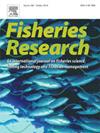Fisherwomen’s activities are as complex, salient, and profitable as those performed by fishermen: A study from vulnerable traditional fishery communities
IF 2.2
2区 农林科学
Q2 FISHERIES
引用次数: 0
Abstract
Examining gender dynamics in small-scale fisheries (SSF) is crucial for understanding the contributions of both women and men and identifying potential inequalities. Although women are a fundamental part of the seafood supply chain in SSF, especially in traditional communities, management remains gender biased. This is partly due to a lack of understanding of gender mainstreaming. To address this, we conducted a participatory fishery monitoring initiative along the Brazilian central coast, focusing specifically on engaging local and traditional communities. Our aims were to analyze the catch volume, labor distribution, target resources, profitability differences between fisherwomen and fishermen, and to examine the intricate intra-community relationships that may influence labor dynamics in these communities. The study revealed fundamental differences in women and men’s fishing activities and profitability. Fisherwomen primarily targeted a set of high-priced resources (e.g., shelled mollusk) that are different from those harvested by fishermen (e.g., fin fish), while also having lower operational costs, given their focus on gleaning. Women also contribute to men’s labor by engaging in the processing of their captures. These factors collectively increased the overall profitability of fisherwomen compared to fishermen. Furthermore, while fishermen depend on fisherwomen’s post-processing services, the activities of fisherwomen are more independent, as revealed by Exponential-family Random Graph Models. The communities-specific profitability assessment developed in this study can be readily adapted for use in other fishing communities where both women and men contribute to catches. Our approach offers valuable insights into gender sensitivities and adaptability within SSFs, serving as a tool for policy making and improving the fishery value chain.
渔民妇女的活动与渔民的活动一样复杂、突出和有利可图:一项来自脆弱传统渔业社区的研究
研究小规模渔业中的性别动态对于了解妇女和男子的贡献以及确定潜在的不平等现象至关重要。虽然妇女是海产品供应链的基本组成部分,特别是在传统社区,但管理仍然存在性别偏见。这部分是由于缺乏对性别主流化的理解。为了解决这一问题,我们在巴西中部海岸开展了一项参与性渔业监测倡议,特别侧重于让当地和传统社区参与进来。我们的目的是分析捕获量、劳动力分布、目标资源、渔民和女性渔民之间的盈利差异,并研究可能影响这些社区劳动力动态的复杂社区内关系。这项研究揭示了妇女和男子在捕鱼活动和利润方面的根本差异。渔民妇女的主要目标是一组高价资源(如有壳软体动物),这些资源不同于渔民捕捞的资源(如鳍鱼),同时由于她们注重收集,作业成本也较低。妇女还参与处理捕获的猎物,从而为男子的劳动作出贡献。与渔民相比,这些因素共同提高了女渔民的总体盈利能力。此外,指数族随机图模型显示,虽然渔民依赖于渔民妇女的后处理服务,但渔民妇女的活动更加独立。本研究编制的针对特定社区的盈利能力评估可以很容易地适用于妇女和男子都对渔获作出贡献的其他渔业社区。我们的方法为可持续渔业渔业内部的性别敏感性和适应性提供了宝贵的见解,可作为政策制定和改善渔业价值链的工具。
本文章由计算机程序翻译,如有差异,请以英文原文为准。
求助全文
约1分钟内获得全文
求助全文
来源期刊

Fisheries Research
农林科学-渔业
CiteScore
4.50
自引率
16.70%
发文量
294
审稿时长
15 weeks
期刊介绍:
This journal provides an international forum for the publication of papers in the areas of fisheries science, fishing technology, fisheries management and relevant socio-economics. The scope covers fisheries in salt, brackish and freshwater systems, and all aspects of associated ecology, environmental aspects of fisheries, and economics. Both theoretical and practical papers are acceptable, including laboratory and field experimental studies relevant to fisheries. Papers on the conservation of exploitable living resources are welcome. Review and Viewpoint articles are also published. As the specified areas inevitably impinge on and interrelate with each other, the approach of the journal is multidisciplinary, and authors are encouraged to emphasise the relevance of their own work to that of other disciplines. The journal is intended for fisheries scientists, biological oceanographers, gear technologists, economists, managers, administrators, policy makers and legislators.
 求助内容:
求助内容: 应助结果提醒方式:
应助结果提醒方式:


